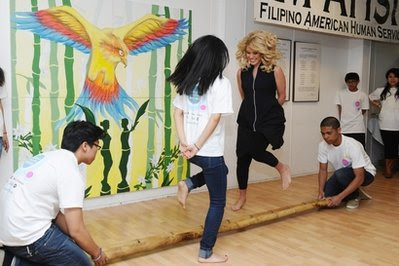SUBIC, Philippines - Two huge former US military bases have found a new lease on life in post-Cold War Philippines, with budget airlines and cargo ships taking the place of fighter jets and destroyers.
The conversion of Subic Naval Base and Clark Air Base into tax-haven special economic zones nearly two decades ago has drawn a few thousand investors that include shipbuilders, electronic firms, airlines and tour operators.
 |
| Subic Naval Base, Zambales |
 |
| Clark Air Base, Pampanga |
The transition, however, has not been smooth and the vast areas, each about the size of Singapore, still do not live up to their potential with parts resembling ghost towns, officials involved in running them acknowledge.
But they now employ around 150,000 people, nearly four times the 42,000 locals when US forces gave up what were then their biggest overseas military facilities in 1992, according to Subic's state-administrator Armand Arreza.
"We're the main economic driver here," Arreza told AFP in an interview at his office at the sheltered deepwater port of Subic.
The US military set up their naval and air presence in 1901 and 1903 respectively as they took colonial control of the Philippines, with Subic becoming the repair and supply yard of the US 7th Fleet that ruled the Pacific.
Clark became the headquarters of the 13th US Air Force and the two bases were among the biggest employers in the Philippines for decades after World War II.
But Clark was forced to close when the nearby Pinatubo volcano erupted in 1991, burying the area under vast amounts of ash.
The following year Subic also closed when, amid rising nationalist sentiment and a dispute over rent, the Philippine Senate refused to renew leases on both bases.
In their place, the government moved quickly to turn the areas -- a couple of hours' drive north of Manila -- into special economic zones that allowed investors to import raw materials, capital and equipment tax free.
The company tax rate in the zones was set at five percent, compared with about 30 percent elsewhere in the Philippines, and foreign businesspeople setting up there were given visa waivers.
Foreign manufacturers -- from makers of electronic chips to door knobs, garments and car parts -- dominated an initial rush in the 1990s.
But some ran into difficulty during the 1998 Asian economic crisis -- a pattern that, most recently, again played out in 2008 with the global financial meltdown.
Arreza and others involved in the process described the post-US withdrawal development as a series of hits and misses.
"There are assets that have been distressed, companies whose business plans have not been as successful," Arreza said.
One major setback came in 2009 when Federal Express moved its regional hub to China, leaving 800 locals without jobs, in what was seen as a symbol of the Philippines' increasing inability to compete with its giant Asian neighbour.
Many manufacturers that initially were attracted to the Philippines had in actual fact shifted operations to China and Vietnam from as early on as the mid-1990s.
Richard Gordon, Subic's first administrator, said one of the key misses was a controversial government decision to strip top Asian port operator Hutchison Whampoa of its winning bid to build a Subic container port in 1995.
"If we'd brought (Hutchison's billionaire owner Li Ka-Shing) to Subic who knows what companies would have come," Gordon told AFP.
The government later borrowed money to build a container port that is now operated by Li's local rival for the original project.
Nevertheless, Clark and Subic have done well compared with the rest of the economy, said John Forbes, investment adviser to the American Chamber of Commerce in the Philippines.
"The Philippines has done extremely well at both the bases... of course they are not being maximised but that's because the Philippine economy has not been maximised," Forbes told AFP.
In a country that has fallen further behind many of its Asian neighbours on a range of vital economic and social criteria over recent decades, the bases have provided a crucial source of money.
Total investments in Subic since its conversion into an economic zone reached $7.2 billion last year, with nearly $5 billion of that coming since 2005, according to government data.
Clark, which has more usable space and a bigger runway, has attracted a total amount of $25 billion, official figures show.
Among the biggest recent investors at Clark are chip-makers Texas Instruments of the United States, which arrived in 2009, and South Korean giant Samsung, which set up operations last year.
The two have so far ploughed 860 million dollars and 135 million dollars respectively out of their initial billion-dollar investment pledges.
Japanese tyre manufacturer Yokohoma, which has been one of the most enduring foreign companies at Clark after arriving in 1996, also has expansion plans.
Meanwhile, regional airline AirAsia is due to make Clark its main Philippine hub in September, joining seven other budget carriers already there.
Over at Subic, Korean shipbuilder Hanjin Heavy Industries has built one of the 10 largest yards in the world which has delivered 20 ships over the past five years.
"Shipbuilding has become an emerging sector for us," said Arreza, adding that the Subic port was now second only to Manila in terms of general cargo volume.
In another sign of progress, Guam-based Aviation Concepts moved into Subic in February to provide fuelling and maintenance services for Asia-based aircraft, as well as air ambulance services.
After Federal Express' departure to China, Subic's airport had remained dormant.
One of the government's main priorities now is to drive more traffic into the former bases to boost aviation and leisure facilities, with the huge Chinese market a top focus.
"Tourism, for me, is the sleeping giant," Arreza said.
"Right now we're into domestic tourism, but of course there's a lot of seasonality and you are vulnerable to domestic conditions. So we want to get budget carriers to come here also for the foreign tourists."
Subic, in particular, has rich tourism potential, boasting tropical beaches and some of the most well-preserved rainforests left in the Philippines.
Subic also already hosts international sporting events such as triathlons, mountain bike tours, sailing and kayak races.
Lance Gokongwei, chief executive of Cebu Pacific Air, one of the seven current Clark operators, said the airport there had the potential to attract as much traffic as Manila's international airport.
"It's just a question of making an investment in infrastructure," Gokongwei told AFP.
"There's a large catchment around Clark, within a one-hour radius I think, (where) there's five or six million potential customers."



 The government website of the Dominican Republic has revealed that the former Philippine leader was honored by the government of the
The government website of the Dominican Republic has revealed that the former Philippine leader was honored by the government of the 




 MANILA, Philippines - "Give Up Tomorrow," a documentary feature film about the case of Paco Larrañaga who was convicted for the 1997 murder of Chiong sisters in Cebu, has bagged the Heineken Audience Award at the 2011 Tribeca Film Festival.
MANILA, Philippines - "Give Up Tomorrow," a documentary feature film about the case of Paco Larrañaga who was convicted for the 1997 murder of Chiong sisters in Cebu, has bagged the Heineken Audience Award at the 2011 Tribeca Film Festival.



